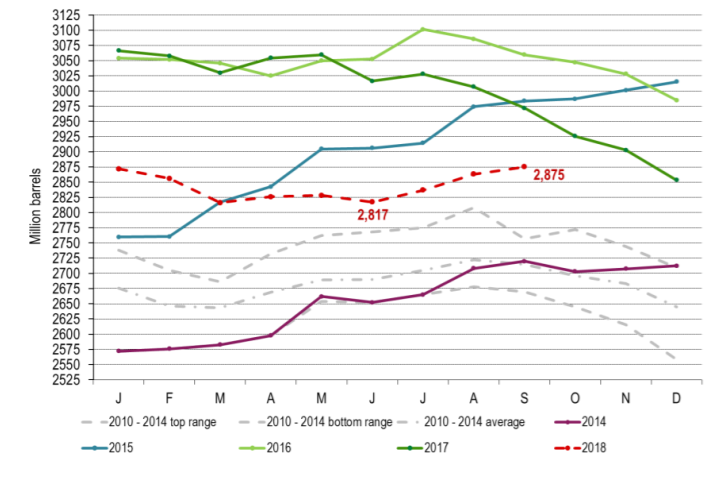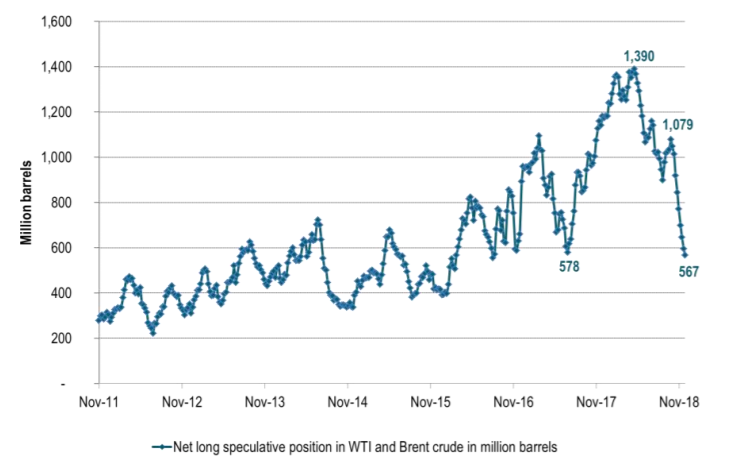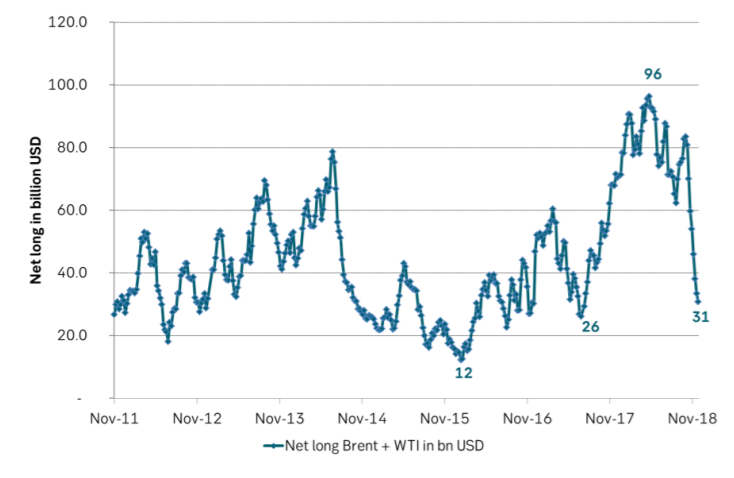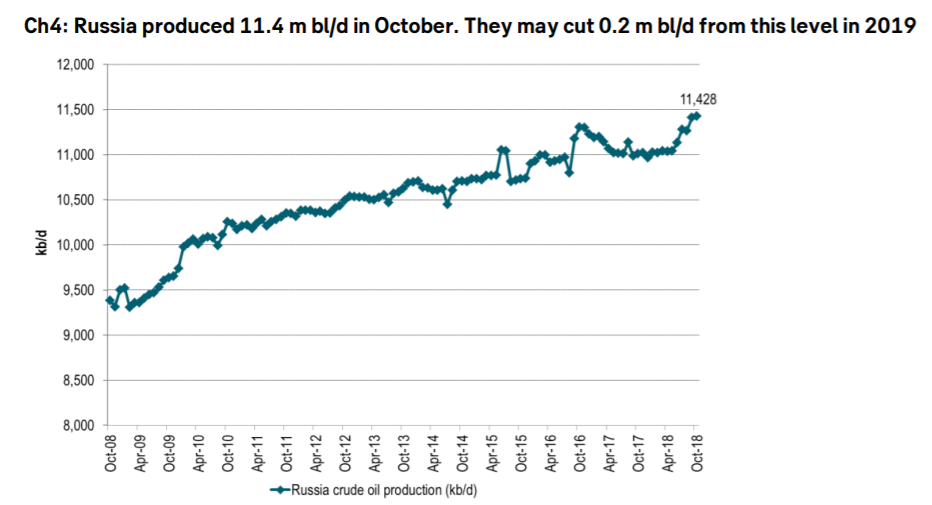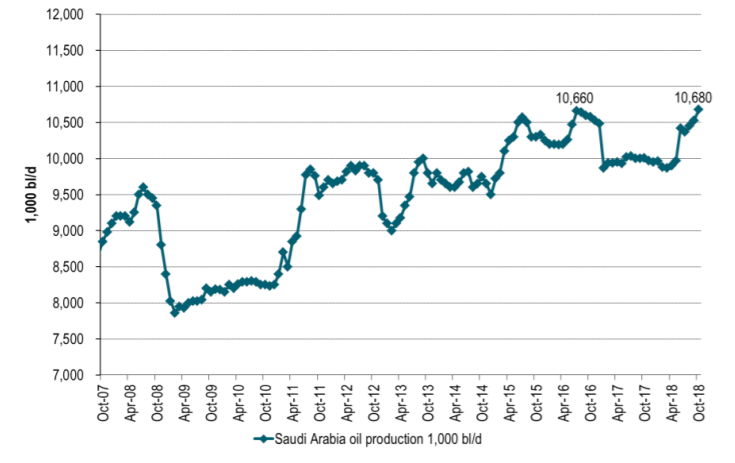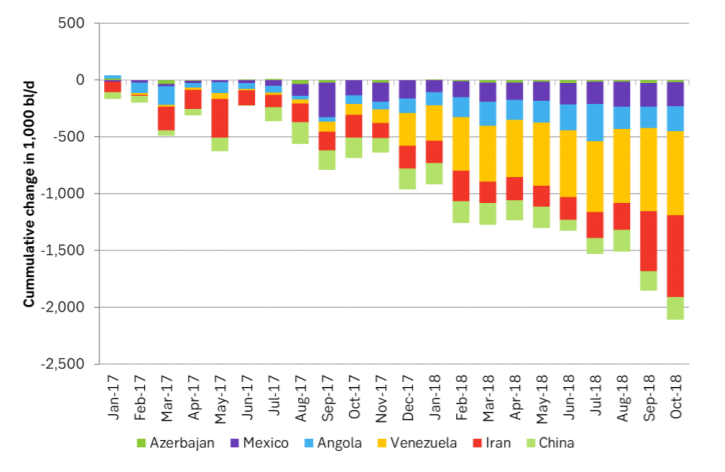Analys
OPEC+ removes the downside price risk

 Russia and Saudi Arabia agreed over the weekend to continue the cooperation of managing supply of crude oil to the market which was initiated in late 2016 in the so called “Declaration of cooperation” between OPEC and 10 cooperating oil producers. No decision of any specific cuts has yet been decided but the message was clear: “We’ll monitor the market situation and react to it quickly”.
Russia and Saudi Arabia agreed over the weekend to continue the cooperation of managing supply of crude oil to the market which was initiated in late 2016 in the so called “Declaration of cooperation” between OPEC and 10 cooperating oil producers. No decision of any specific cuts has yet been decided but the message was clear: “We’ll monitor the market situation and react to it quickly”.
While they may disagree on what is the right price to aim for they are all in agreement that they do not want global oil inventories to rising back up again.
Specific strategy and cuts will be communicated later this week when OPEC meets in Vienna on 6 December.
The key take away from all of this is that global oil inventories will not rise back up, the Brent crude oil price curve will not bend deeper and deeper into contango and the front month Brent crude oil will not dive yet lower to USD 55, 50, 45,…/bl.
Exactly in what price range above USD 60/bl we’ll end up depends on the final decision, strategy and communication from OPEC+ at the end of this week.
Canada, Alberta’s Premier Rachel Notley decided this weekend to cut Alberta’s oil production by 325 k bl/d from January onwards until local inventories are back down to normal. Alberta is the largest oil producer in Canada and the cut constitutes a reduction of 8.7% in Alberta. After that the production cuts will be reduced to 95 k bl/d until the end of 2019. Together with the agreement between Russia and Saudi Arabia this weekend this adds to the forward fundamental price support picture.
OPEC’s Advisory Committee last week estimated that OPEC needs to cut production by 1.3 m bl/d versus its October level of 33 m bl/d in order to balance the market next year. I.e. it estimated a call-on-OPEC for 2019 of 31.7 m bl/d. In comparison the IEA in November estimated a call-on-OPEC for 2019 of 31.3 m bl/d. OPEC has produced 32.2 m bl/d on average ytd.
A contracting call-on-OPEC is of course unsustainable over time. As such the estimated decline in call-on-OPEC in 2019 is fundamentally problematic. Internal dynamics within OPEC will however decide how problematic this is. For 2019 we expect production in Venezuela to decline further from an average of 1.4 m bl/d this year to only 1.0 m bl/d in 2019. In addition we expect Iran’s production to be roughly 0.4 m bl/d lower on average in 2019 than in 2018. So here already we have internal OPEC declines of some 0.8 m bl/d y/y to 2019 which reduces the needs for cuts by the other members. So with help also from Russia and the other 9 cooperating countries the magnitude of needed active cuts by those who have to cut will not amount to all that much. The amount of needed cuts by the active cutters within OPEC+ can of course change rapidly due to very unpredictable production in Libya, Nigeria and Angola just to mention a few.
Russia has been very reluctant to join in on further cuts and has stoically announced that it is fine with almost any oil price next year. In our view Russia seems to be concerned over the very strong US crude oil production growth. As such its position as we read it is twofold: 1) It does not want to see global inventories rising back up again and 2) It wants an oil price at a level which tempers US shale oil production growth. The challenge for Russia thus seems to be how to cut production without driving up the oil price too much.
The Brent crude oil price has rebounded close to 4% this morning to USD 61.7/bl but seems to have halted there waiting for the details and specifics to materialize. The Joint Ministerial Monitoring Committee which works on behalf of OPEC+ will meet in Vienna on 5 December and discuss needed action. Its recommendation will be the foundation for the OPEC ministerial meeting and the full meeting of OPEC+ the following day.
Ch1: OECD commercial inventories have increased 58 m bl from June to September. Inventories normally increase 25 m bl this period of year. Thus adjusting for seasonality the inventories rose only 33 m bl over these three months
Ch2: Net long speculative positions in million barrels for Brent + WTI down to the previous lows since start of 2016
Ch3: Net long speculative positions in billion USD for Brent + WTI close to the low of mid-2017. Crude prices were even lower in mid-2017 and of course crude prices were much higher in 2011, 2012, 2013 and partially also 2014
Ch4: Russia produced 11.4 m bl/d in October. They may cut 0.2 m bl/d from this level in 2019
Ch5: Saudi Arabia produced 10.7 m bl/d and can easily cut production by 0.2 to 0.4 m bl/d in 2019
Ch6: Production losses from selected countries have led to losses of more than 2 m bl/d since early 2017. We expect further losses also in 2019. How much will of course strongly impact the supply/demand balance in the oil market and thus the need for active production cuts by OPEC+ or those who can cut in OPEC+. As Aleksander Novak said: ”we don’t know yet if there will be a surplus in 2019 or not”. Putin’s statement this weekend “…we will monitor the market and react to it quickly” is thus a natural continuation of this.
Analys
Tightening fundamentals – bullish inventories from DOE

The latest weekly report from the US DOE showed a substantial drawdown across key petroleum categories, adding more upside potential to the fundamental picture.

Commercial crude inventories (excl. SPR) fell by 5.8 million barrels, bringing total inventories down to 415.1 million barrels. Now sitting 11% below the five-year seasonal norm and placed in the lowest 2015-2022 range (see picture below).
Product inventories also tightened further last week. Gasoline inventories declined by 2.1 million barrels, with reductions seen in both finished gasoline and blending components. Current gasoline levels are about 3% below the five-year average for this time of year.
Among products, the most notable move came in diesel, where inventories dropped by almost 4.1 million barrels, deepening the deficit to around 20% below seasonal norms – continuing to underscore the persistent supply tightness in diesel markets.
The only area of inventory growth was in propane/propylene, which posted a significant 5.1-million-barrel build and now stands 9% above the five-year average.
Total commercial petroleum inventories (crude plus refined products) declined by 4.2 million barrels on the week, reinforcing the overall tightening of US crude and products.


Analys
Bombs to ”ceasefire” in hours – Brent below $70

A classic case of “buy the rumor, sell the news” played out in oil markets, as Brent crude has dropped sharply – down nearly USD 10 per barrel since yesterday evening – following Iran’s retaliatory strike on a U.S. air base in Qatar. The immediate reaction was: “That was it?” The strike followed a carefully calibrated, non-escalatory playbook, avoiding direct threats to energy infrastructure or disruption of shipping through the Strait of Hormuz – thus calming worst-case fears.

After Monday morning’s sharp spike to USD 81.4 per barrel, triggered by the U.S. bombing of Iranian nuclear facilities, oil prices drifted sideways in anticipation of a potential Iranian response. That response came with advance warning and caused limited physical damage. Early this morning, both the U.S. President and Iranian state media announced a ceasefire, effectively placing a lid on the immediate conflict risk – at least for now.
As a result, Brent crude has now fallen by a total of USD 12 from Monday’s peak, currently trading around USD 69 per barrel.
Looking beyond geopolitics, the market will now shift its focus to the upcoming OPEC+ meeting in early July. Saudi Arabia’s decision to increase output earlier this year – despite falling prices – has drawn renewed attention considering recent developments. Some suggest this was a response to U.S. pressure to offset potential Iranian supply losses.
However, consensus is that the move was driven more by internal OPEC+ dynamics. After years of curbing production to support prices, Riyadh had grown frustrated with quota-busting by several members (notably Kazakhstan). With Saudi Arabia cutting up to 2 million barrels per day – roughly 2% of global supply – returns were diminishing, and the risk of losing market share was rising. The production increase is widely seen as an effort to reassert leadership and restore discipline within the group.
That said, the FT recently stated that, the Saudis remain wary of past missteps. In 2018, Riyadh ramped up output at Trump’s request ahead of Iran sanctions, only to see prices collapse when the U.S. granted broad waivers – triggering oversupply. Officials have reportedly made it clear they don’t intend to repeat that mistake.
The recent visit by President Trump to Saudi Arabia, which included agreements on AI, defense, and nuclear cooperation, suggests a broader strategic alignment. This has fueled speculation about a quiet “pump-for-politics” deal behind recent production moves.
Looking ahead, oil prices have now retraced the entire rally sparked by the June 13 Israel–Iran escalation. This retreat provides more political and policy space for both the U.S. and Saudi Arabia. Specifically, it makes it easier for Riyadh to scale back its three recent production hikes of 411,000 barrels each, potentially returning to more moderate increases of 137,000 barrels for August and September.
In short: with no major loss of Iranian supply to the market, OPEC+ – led by Saudi Arabia – no longer needs to compensate for a disruption that hasn’t materialized, especially not to please the U.S. at the cost of its own market strategy. As the Saudis themselves have signaled, they are unlikely to repeat previous mistakes.
Conclusion: With Brent now in the high USD 60s, buying oil looks fundamentally justified. The geopolitical premium has deflated, but tensions between Israel and Iran remain unresolved – and the risk of missteps and renewed escalation still lingers. In fact, even this morning, reports have emerged of renewed missile fire despite the declared “truce.” The path forward may be calmer – but it is far from stable.
Analys
A muted price reaction. Market looks relaxed, but it is still on edge waiting for what Iran will do

Brent crossed the 80-line this morning but quickly fell back assigning limited probability for Iran choosing to close the Strait of Hormuz. Brent traded in a range of USD 70.56 – 79.04/b last week as the market fluctuated between ”Iran wants a deal” and ”US is about to attack Iran”. At the end of the week though, Donald Trump managed to convince markets (and probably also Iran) that he would make a decision within two weeks. I.e. no imminent attack. Previously when when he has talked about ”making a decision within two weeks” he has often ended up doing nothing in the end. The oil market relaxed as a result and the week ended at USD 77.01/b which is just USD 6/b above the year to date average of USD 71/b.

Brent jumped to USD 81.4/b this morning, the highest since mid-January, but then quickly fell back to a current price of USD 78.2/b which is only up 1.5% versus the close on Friday. As such the market is pricing a fairly low probability that Iran will actually close the Strait of Hormuz. Probably because it will hurt Iranian oil exports as well as the global oil market.
It was however all smoke and mirrors. Deception. The US attacked Iran on Saturday. The attack involved 125 warplanes, submarines and surface warships and 14 bunker buster bombs were dropped on Iranian nuclear sites including Fordow, Natanz and Isfahan. In response the Iranian Parliament voted in support of closing the Strait of Hormuz where some 17 mb of crude and products is transported to the global market every day plus significant volumes of LNG. This is however merely an advise to the Supreme leader Ayatollah Ali Khamenei and the Supreme National Security Council which sits with the final and actual decision.
No supply of oil is lost yet. It is about the risk of Iran closing the Strait of Hormuz or not. So far not a single drop of oil supply has been lost to the global market. The price at the moment is all about the assessed risk of loss of supply. Will Iran choose to choke of the Strait of Hormuz or not? That is the big question. It would be painful for US consumers, for Donald Trump’s voter base, for the global economy but also for Iran and its population which relies on oil exports and income from selling oil out of that Strait as well. As such it is not a no-brainer choice for Iran to close the Strait for oil exports. And looking at the il price this morning it is clear that the oil market doesn’t assign a very high probability of it happening. It is however probably well within the capability of Iran to close the Strait off with rockets, mines, air-drones and possibly sea-drones. Just look at how Ukraine has been able to control and damage the Russian Black Sea fleet.
What to do about the highly enriched uranium which has gone missing? While the US and Israel can celebrate their destruction of Iranian nuclear facilities they are also scratching their heads over what to do with the lost Iranian nuclear material. Iran had 408 kg of highly enriched uranium (IAEA). Almost weapons grade. Enough for some 10 nuclear warheads. It seems to have been transported out of Fordow before the attack this weekend.
The market is still on edge. USD 80-something/b seems sensible while we wait. The oil market reaction to this weekend’s events is very muted so far. The market is still on edge awaiting what Iran will do. Because Iran will do something. But what and when? An oil price of 80-something seems like a sensible level until something do happen.
-

 Nyheter3 veckor sedan
Nyheter3 veckor sedanStor uppsida i Lappland Guldprospekterings aktie enligt analys
-

 Nyheter4 veckor sedan
Nyheter4 veckor sedanBrookfield ska bygga ett AI-datacenter på hela 750 MW i Strängnäs
-

 Nyheter4 veckor sedan
Nyheter4 veckor sedanSommaren inleds med sol och varierande elpriser
-

 Nyheter3 veckor sedan
Nyheter3 veckor sedanSilverpriset släpar efter guldets utveckling, har mer uppsida
-

 Analys4 veckor sedan
Analys4 veckor sedanBrent needs to fall to USD 58/b to make cheating unprofitable for Kazakhstan
-

 Nyheter4 veckor sedan
Nyheter4 veckor sedanTradingfirman XTX Markets bygger datacenter i finska Kajana för 1 miljard euro
-

 Nyheter2 veckor sedan
Nyheter2 veckor sedanUppgången i oljepriset planade ut under helgen
-

 Nyheter2 veckor sedan
Nyheter2 veckor sedanLåga elpriser i sommar – men mellersta Sverige får en ökning



